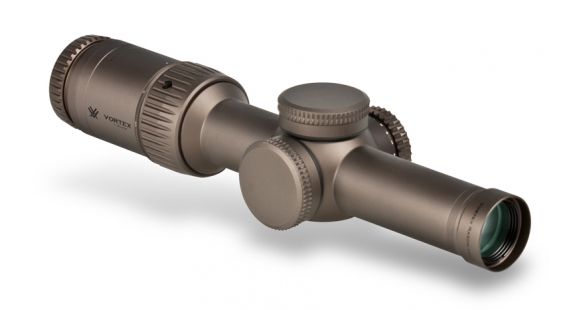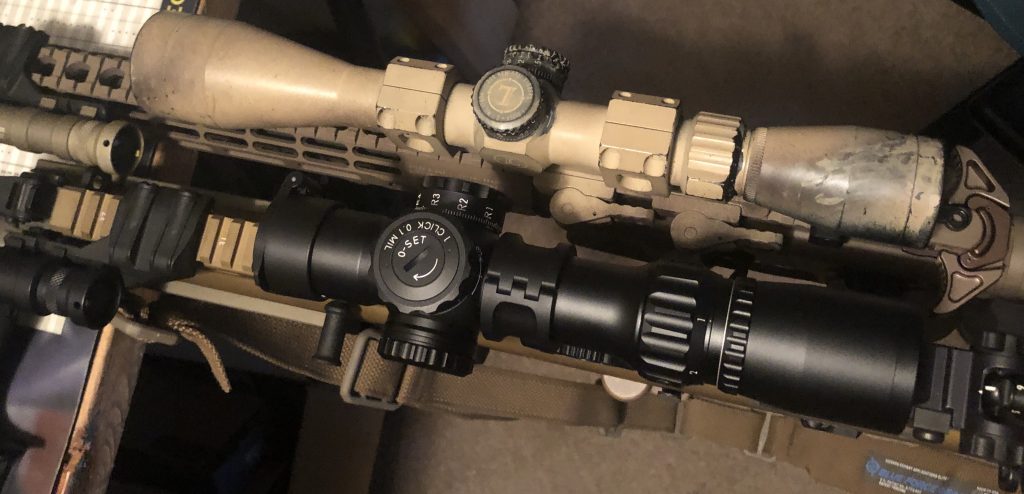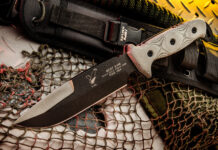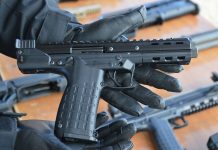
It’s everywhere. Across every blog, YouTube channel, and newsletter. LPVO “El Pea Vee Oh” is yet another acronym in our acronym heavy hobby. The four letters describe an optic category that isn’t new. In fact, this theory started to emerge for rifles like the M16 and M4 in the mid 90’s and low power scopes were in common use on combat/sniper rifles in WWII.
While it is not a new theory, today is certainly its mainstream golden age.
The “first” LPVO might be considered the Schmidt & Bender Short Dot or Gen I CQB Short Dot, developed in response to the after action findings of Gothic Serpent. Better known for the book and movie Black Hawk Down, Gothic Serpent highlighted the limitations of both iron sights and red dot sights (also not “new” tech) for identifying targets at distances 100 yards and beyond amongst the chaos of an urban environment.
The S&B Gen I CQB SD came from the identified needs of shooters in SOCOM/SFOD and were tailored to those needs. Red dot CQB versatility, the ability to take longer shots on partially exposed threats in cover, and the clarity to positively ID threat/non-threats in that same environment.
Why did it take 25 years for the general population to catch up on LPVOs?
Market demands, legal obstacles, nobody knew, and the “Big Army” tech base.
The carbine LPVO was SOCOM’s baby and they only needed a few hundred. Those few hundred were built by a company whose primary market was high end hunting scopes. They didn’t need to throw the Short Dot into every hunting magazine and hope to sell a bunch commercially too.
Legally this was the era of the Clinton Crime Bill and the oh so epic a piece of nothing that was the Assault Weapon Ban. So with the AR15 all but neutered out of the market an optic for that same rifle wasn’t in high demand. No mass market demand, no mass market buy. In 2004 the ban sunset and the AR market began to wake up again.
Ok, but that was still 15 years ago… why no LPVO’s then?
Indeed. The LPVO had been around for a decade in a small circle of shooters who had asked for it, but the civilian market for the AR was very slowly reawakening. That market had been stymied for that decade where the Short Dot emerged and during that time three other optics came to be, and in far greater numbers. The Aimpoint RDS, the EOTech HWS, and the Trijicon ACOG. With the Army, Marines, and Special Forces taking on the missions of GWOT with those three (and lots of cool pictures too), LPVOs again didn’t see any heroic limelight.
Then Magpul dropped “The Art of the Tactical Carbine” around the end of 2008 and the private training market exploded. So did the market for anything and everything AR/M16/M4… except LPVO’s. Colt was still the gold standard of AR15’s and the smaller, now well known names, weren’t around. It was a different time. Hell, Bushmaster was a respected AR name.
Then in 2011 Leupold releases the MK8 CQBSS and the public consumption of the LPVO began in earnest. Thanks to the internet, Gun Owners Gen 2.0, video game exposure, and GWOT veterans entering the training and public sphere more and more.

That was still 8 years ago…
Yep, it was. LPVO’s were either old tech to the guys who had been using them since the 90’s, or are very new and very expensive tech to the guys and gals learning about them for the first time. The Leupold TS30-A2 Mark 4 MR/T 2.5-8×36 and NightForce NXS 2.5-10×24 had both come to light in conjunction with the Mk12 SPR/DMR, but those were not seen as carbine or service rifle optics. The variable optics were for Designated Marksman rifles and they were treated with kid gloves, seen as incredibly fragile.
Long(er), heavy(ier), “fragile”, regular scope rings were too low and kept the scope too far back for good eye relief, and the tactical optic trio were still the kings. For people wanting to spend “big money” or “smart money” on a tactical rifle optic LPVO’s still had ground to make up before for wide market acceptance would occur.
The Razor’s Edge

The most recognizable optic, the one that finally crossed all the right boxes, is the Vortex Razor HD Gen II. It was 1-6 power and that was cool. It was “tan” and that was really cool. It was used by SOCOM on M4’s and Mk18’s and that was really really cool!
And… It didn’t cost twice what your rifle did.
It was/is an LPVO with the “Operator” stamp in reasonable dollars distance from the tactical trio, especially the ACOG which was most comparable capability wise. It was still longer and heavier, by a factor of about two, than the trio but we had broken into commercially viable territory. With glowing recommendations on the Razor Gen II’s performance LPVO’s were beginning to lose their “fragile” and “unobtainable” descriptors.
The LPVO Today

The three major arms of the US Military conducting ground combat operations, SOCOM, the Army, and the Marines, have all solicited for or selected LPVO optics to enter their inventories starting in the next couple years. The Squad Common Optic (SCO) will replace the RCO (a TA31 ACOG) and SDO (a TA11 ACOG) in the hands of US Marines, for example. Indications are that, budget willing, the optic will go fleetwide starting with infantry/combat arms units.
The lessons brought home in the 90’s by the Delta guys and Rangers of Gothic Serpent have permeated the collective. Combined with steady continual increases in tech base capabilities and the mass information flow, evaluation, and exchange of ideas provided by the internet the LPVO has gained a hold in every market segment of the shooting community.
The LPVO Future
Now that the barriers of knowledge and price have crumbled away (you can find a Nikon 1-4 for $199, new) the only two remaining detractor considerations are.
- Size
- Weight
Those are rapidly vanishing too.

Pictured (and in the title image) is the newest glass I purchased from March Optics, the March F 1-8x24mm Shorty. At only 8.4″ long and 17.1oz the scope is among smallest on the market, especially in the 1-8x category.
Probably the most radical departure in design I’ve seen so far is the single ring mounting. Every other variable optic I’ve dealt with, unless it has an integral mount (Elcan, VCOG), used two rings.
The March design is such that it must use a single 30mm ring, and with a market base that supported the Aimpoint 30mm sights and their clone/derivatives, several excellent mount options exist. I grabbed up a ScalarWorks LEAP PRO and it’s working perfectly so far. But when I asked ScalarWorks and Geissele both if their mounts would support a variable scope they both responded, “We’ve never tried that…”
So ScalarWorks and I made an educated guess upon the evidence and said,
- It’s designed for one ring
- It’s only 6 oz heavier than the Aimpoint PRO
- Screw it, let’s do it live… For Science!

Immediately, although not an issue on the SCAR its riding on, the mount placement eliminates a lot of the inflexibility of positioning scopes for eye relief on the top rails of AR-15s. The March F’s size and that small footprint on the rail lends itself greatly to being an exceptional SBR option. With the ScalarWorks LEAP it’s 19.6 oz total, quick detach, 1-8x, Front Focal Plane.
Smaller, lighter, more durable, more flexible in more roles, the LPVO tech base is probably the most fun to follow in the industry at present.

Review on the March F to follow. But with the emerging feature sets of it, and scopes that will compete against it, for defense and action shooting sports roles (worlds that have become closely linked) I am ecstatic to keep following and testing this.



